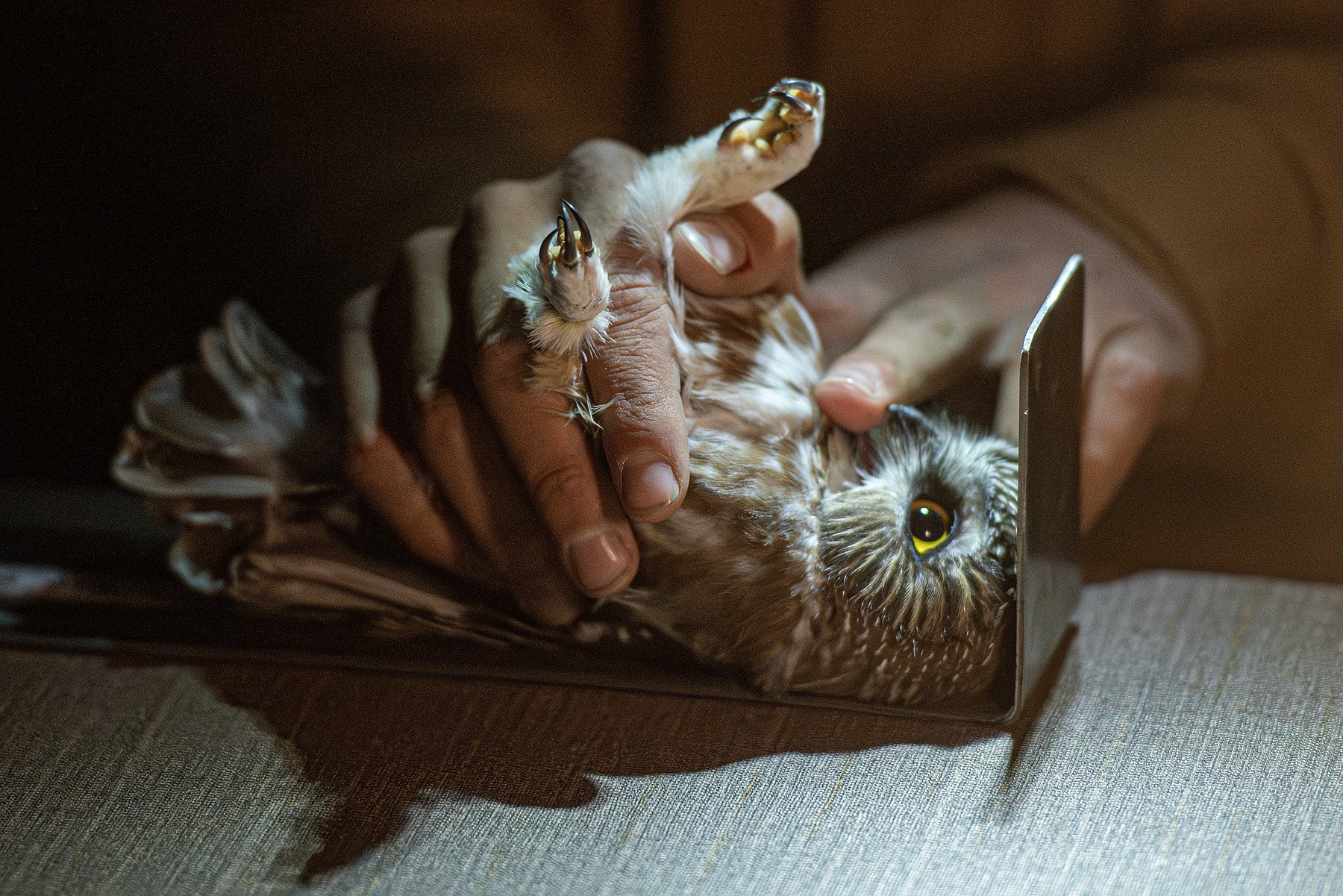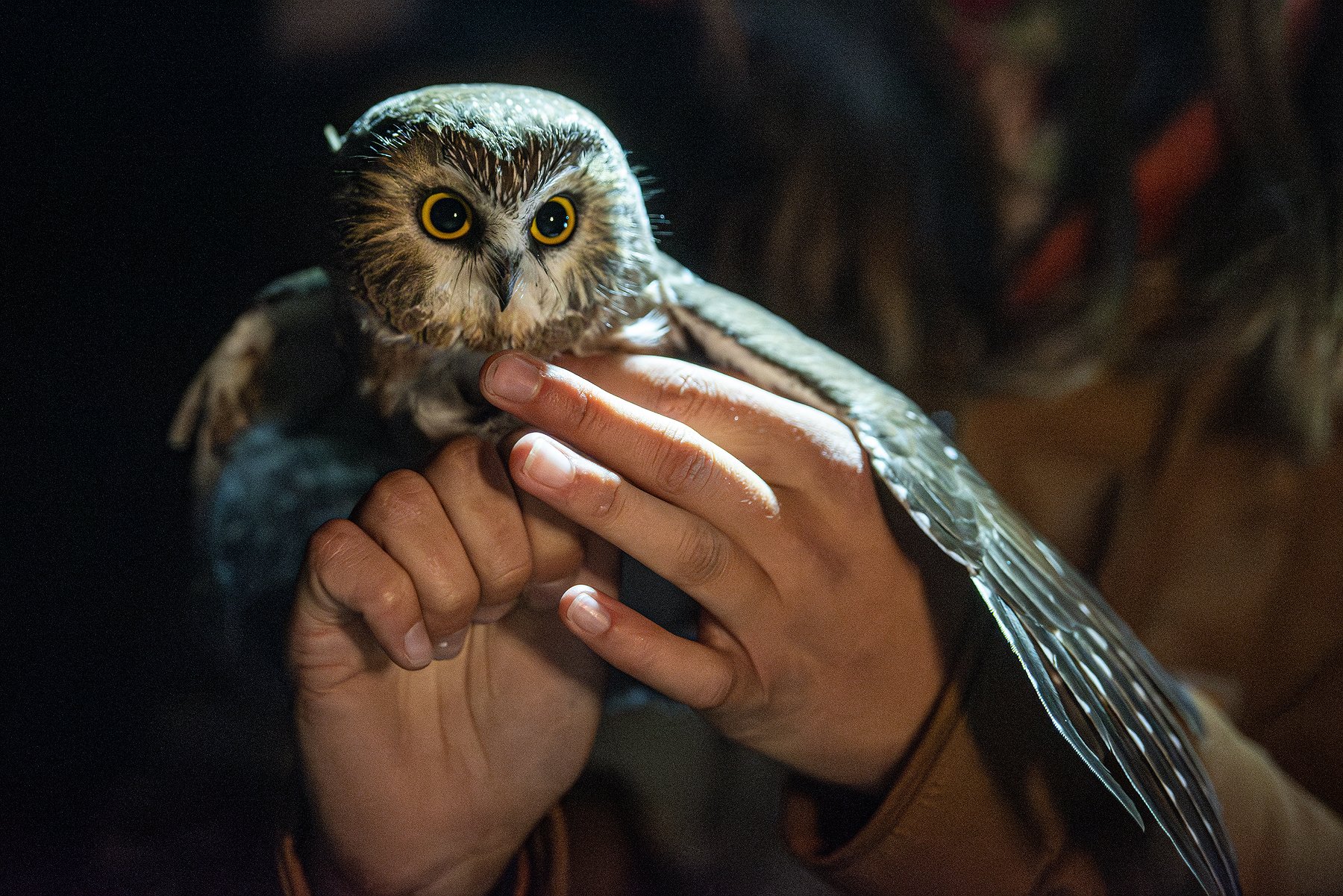Migration Mystery: ORI seeks to track saw-whet owls’ journey through Montana
AVERY HOWE | Hagadone News Network | UPDATED 1 year, 1 month AGO
At 7:20 p.m., a northern saw-whet owl call pierces through the forest at Flathead Lake Biological Station. Although these little owls are some of the more common on the North American continent and native to Northwest Montana’s woods, this sound is coming from a speaker.
Lauren Tate is the field technician and head bander for Owl Research Institute’s saw-whet owl banding site at the Bio Station. This is the second year the program has run here. As of last Tuesday, over 156 saw-whets had been caught for this season, reaching towards 2023’s tally of 180. Tate, in partnership with Flathead Audubon Society, led two public outings this month to allow a small group of observers to experience the banding process.
ORI, based out of Charlo, also has saw-whet stations in Missoula and Ronan. The main reason for setting up a station on Flathead Lake was the ability to lease land from the Bio Station, though the number of owls banded there has proved to be similar to other locations.
“In my mind they’re using this corridor of the eastern edge of the lake and the western front... they don’t really fly over the lake, they have to go on one end or the other,” Tate said.
Saw-whet banding started on the east coast about 30 years ago. Now there are over 200 stations across the country attempting to track migration and learn more about the lifestyle of the birds. Their habitat ranges from Alaska to the mountains of Central Mexico. Tate explained that saw-whets are considered partially migratory.
The call playing on Tate’s speaker is a male territorial call used in the spring breeding season. The call being out of season seems to pique the birds’ interest nonetheless. Six super-fine mist nets hang around the speaker in sort of a star pattern. When the owls come to investigate, they’re caught. Females tend to be captured more often than males.
“You might think that’s because she’s attracted to the male call, but when they first started this project, they didn’t use the speaker at all and they would catch pretty much the same demographics,” Tate said.
It is thought that females move with their food sources and males stay closer to their breeding territories to be prepared for spring, which may explain the sex differential. Banding at the Bio Station will help contribute to a global effort to determine migration routes, timing and habitat use of saw-whets.
Tate and her volunteer helpers visit the mist nets every 30 minutes, from five hours after sunset, every night of the week except Monday.
The first owl she emerges from the mist nets with is wide-eyed and quiet as Tate brings it to the lantern-lit banding table, visitors gathering around as she grabs a pair of sealing pliers to apply the bird’s leg band. She must check its heavily feathered legs for other bands first to make sure it isn’t double-marked. The metal band is perfectly sized for the owl, the pliers too, so no matter how hard she squeezes it shut, it can’t hurt the bird. She checks to make sure no feathers are caught before completing the seal. This way, each bird has an identifying number in case of recapture that can help researchers track its travels.
Lots of saw-whets banded by ORI in Montana are recaptured in Idaho; they have also had owls pop back up in California and British Columbia shortly after being banded in Montana, showing that migration may not be a strict north-to-south flow.
The second owl of the night is a little feistier, clacking its bill in defense as Tate bands its leg and takes her samples. This is a stark difference from the short monotonous whistles playing over the speaker, and although the owl is not particularly happy, it still makes no effort to chomp at its handler's fingers.
The bird’s wing length, overall height, and tail length are recorded. To measure weight, the birds are dunked headfirst into a sock and dangled from a hanging scale. Eye color, muscle and fat are qualitatively valued.
“The idea behind all the data I’m taking tonight, and in the past 23 days and future 20 days, is just to get as much as we possibly can,” Tate said.
Tate turns the lantern off and spreads the little bird’s wing out as a volunteer shines a UV flashlight over its feathers, which glow a pinkish purple. Porphyrins, a pigment in wing feathers, are highlighted by this method. The more they illuminate, the newer the feathers and fresher the molt.
The most important things ORI does, other than marking for recapture, involve sexing the birds. Saw-whets are not sexually dimorphic, the males and females of the species look identical. Two body feather samples are taken -- one to be put in ethanol and the other kept in a dry envelope -- to be DNA tested. Tate also measures the distance between the owls’ front and back toes. This has been proven to be helpful for sexing eagles and could be determined useful for Saw-whet sexing after DNA confirmation. Females are also thought to be slightly larger and heavier than males.
When Tate releases the saw-whets, a short distance from the banding table, they flap off, illuminated by her head lamp like oversized moths, and disappear into the darkness of the forest. There have only been a couple recaptures from owls that returned to the net setup.
As DNA results return to ORI, they hope to have a better understanding of how these majestic (and cute) little owls live their lives. The Bio Station nets will come down in a couple weeks as the weather gets cold.
To follow ORI’s research projects and learn more about Saw-whets, visit owlresearchinstitute.org.
Upcoming Flathead Audubon events will include a Creston Raptor Quest Nov. 7 to identify migrating raptors. Visit flatheadaudubon.org for more information.
ARTICLES BY AVERY HOWE

Bug Creek project making headway near Bigfork
Flathead Area Mountain Bikers and Flathead National Forest will continue work on the forest’s first dedicated mountain bike trails around Crane Mountain this spring.
Neighbors, health department oppose addition to wellness retreat
Bigfork Land Use Advisory Committee heard a request from Samaa Retreat for a conditional use permit to add a retreat center building on their property on Aero Lane during their Thursday, Feb. 27 meeting.
Public offers mixed opinions on Lakeside sewer permit
Views were split in Thursday’s hearing. The majority of speakers were in favor of the permit, composed of public works employees, a few elected officials and members of the public.







